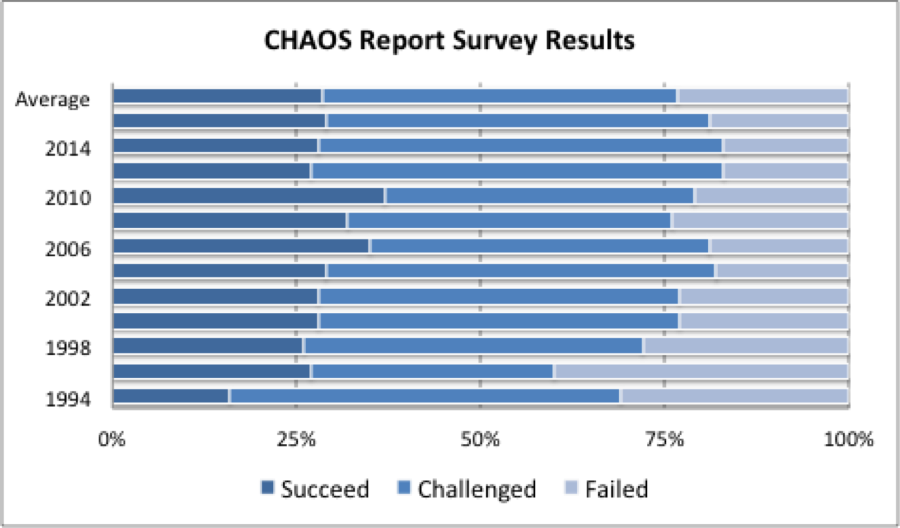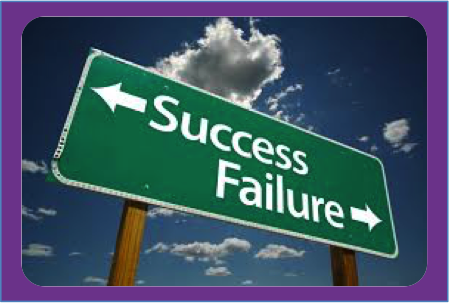The Standish Group has published its annual CHAOS Report on the state of software development since 1994. The Report is often cited as a key metric for the industry’s performance and progress. The yearly update draws much attention.
Analyzing the long-term trends provides an interesting perspective. Over the past two decades, there has been little change in the headline results. On average:
- 29% of projects “succeed” in delivering the desired functionality, on-time and on-budget;
- 48% of projects are “challenged” and do not meet scope, time, or budget expectations; and
- 23% of projects “fail” and are canceled.

While there is some year-to-year variability in these scores, the trend line is essentially flat. In other words, we are no better at delivering a project today than we were 20-years ago. However, when you dive into the data there are some bright spots and markers for the future improvement:
- Smaller is better;
- People are the primary driver of project success or failure; and
- Agile projects are far more likely to succeed.
Here are my interpretations of the Report’s findings and opportunities for the project management profession:
Go Small—Be Successful
Size matters. Small is better. Small projects are more likely to succeed than large ones. Small companies are also better at delivering successful projects than their bigger counterparts.
Small projects succeed 62% of the time compared to 6% of large and 2% of grand projects. Small companies have a higher success rate than large firms. At large companies, only 9% of projects succeed compared with 28% for small companies.
Challenged projects at small companies are likely to deliver more scope than at large companies. Challenged projects at small companies delivered 74% of planned features and functions as opposed to 42% for large companies. On average, challenged projects, regardless of company size, take about twice as long to complete as planned.
Behind these statistics are well-known and intuitive drivers. Bigger projects are more complex. It’s harder to coordinate “all those moving parts” and effectively manage large teams. The Report includes a matrix that expresses the relationship between size/complexity and likelihood of success.
Opportunities for reducing scale and improving the likelihood of success include:
- Breaking large projects into incremental builds;
- Avoiding “big bang” implementations;
- Organizing teams into self-contained squads of 7-11 people; and
- Restructuring the work to avoid scale and complexity.
People Matter
Over the years, the Standish Group has asked what contributes to successful projects. The results are consistent—it’s the people. In the 2014 survey, the top three factors were:
- User involvement (16%);
- Executive support (14%); and
- Clear requirements (13%).
Challenged and failed projects cited the same factors for their woes. Unclear or changing requirements were the leading factor (24%) and lack of user involvement and executive support accounted for 20% of the responses.
Executive support and user involvement are critical success factors for any project. When executives support the project and users are engaged in developing the application there is greater likelihood that the final product will meet expectations. Unclear or unstable requirements are often a symptom of low engagement and support.
Emotional intelligence is also an important factor. Teams with high emotional intelligence are 3-times more likely to succeed than those with moderate or poor skills. Teams that can effectively communicate and collaborate are better at resolving issues and solving problems.
There are many ways to increase engagement and improve team collaboration. See: Projects are About People: 7 Ways to Put People First and Agile Transformation: It’s About the People.
Go Agile–It Works
With Agile projects becoming more prevalent, the Report now provides statistics differentiating success rates between Agile and Waterfall projects. The bottom line—Agile is better.
Overall, Agile projects are 3-times more likely to succeed than Waterfall (39% vs. 11%). Large and medium projects show dramatic improvement. Large projects increase their success rates from 3% to 18% and medium projects from 7% to 27%. Small projects demonstrate smaller gains (44% vs. 58%).
It is no coincidence that Agile projects outperform Waterfall. Agile processes increase engagement and are focused on delivering software that meets expectations:
- The Agile Manifesto encourages change as key to success. The minimum viable product along with frequent releases supports these objectives;
- Agile embraces the user (the product owner) and places them in a critical role on the project team; and
- Ceremonies such as sprint reviews and showcases promote engagement and ensure the product meets expectations.
Not surprisingly, Agile proficiency is listed as an important factor (7%) to the success of these projects. Agile methodologies provide the structure to fundamentally change how software is developed. However, there is a large difference between following a process and engaging in a different way of working.
Project managers do not often have the opportunity to use empirical findings to assess what works. We tend to use anecdotal information or legendary successes or failures to form our opinions. The annual CHAOS Report provides a great opportunity to use trended historical data to measure the impact of changes in the profession.
© 2016, Alan Zucker; Project Management Essentials, LLC. To subscribe
Sources:
2010 IT Project Success Rates. (2012, August 2). Retrieved July 28, 2016, from http://www.drdobbs.com/architecture-and-design/2010-it-project-success-rates/226500046
Cohn, M. (2012, February 2). 2011 CHAOS Report Says Agile is More Successful Than Waterfall. Retrieved July 28, 2016, from https://www.mountaingoatsoftware.com/blog/agile-succeeds-three-times-more-often-than-waterfall
Standish Group 2015 Chaos Report – Q&A with Jennifer Lynch. (2015, October 24). Retrieved July 28, 2016, from https://www.infoq.com/articles/standish-chaos-2015
The CHAOS Report (1994). (1995). Retrieved July 31, 2016, from http://www.csus.edu/indiv/v/velianitis/161/chaosreport.pdf
The CHAOS Report (2014). (2014). Retrieved July 31, 2016, from https://www.projectsmart.co.uk/white-papers/chaos-report.pdf
Zucker, A. (2016, January 01). Projects are About People-7 Ways to Put People First. Retrieved August 06, 2016, from https://www.linkedin.com/pulse/projects-people7-ways-put-people-first-alan-zucker?trk=mp-author-card
Zucker, A. (2016, July 06). Agile Transformation: It’s About the People. Retrieved August 6, 2016, from https://www.linkedin.com/pulse/agile-transformationits-people-alan-zucker?trk=mp-reader-card
Image Courtesy of: http://www.trasys.be/category/blogdigit/


4 thoughts on “Successful Projects: What We Really Know”
Comments are closed.